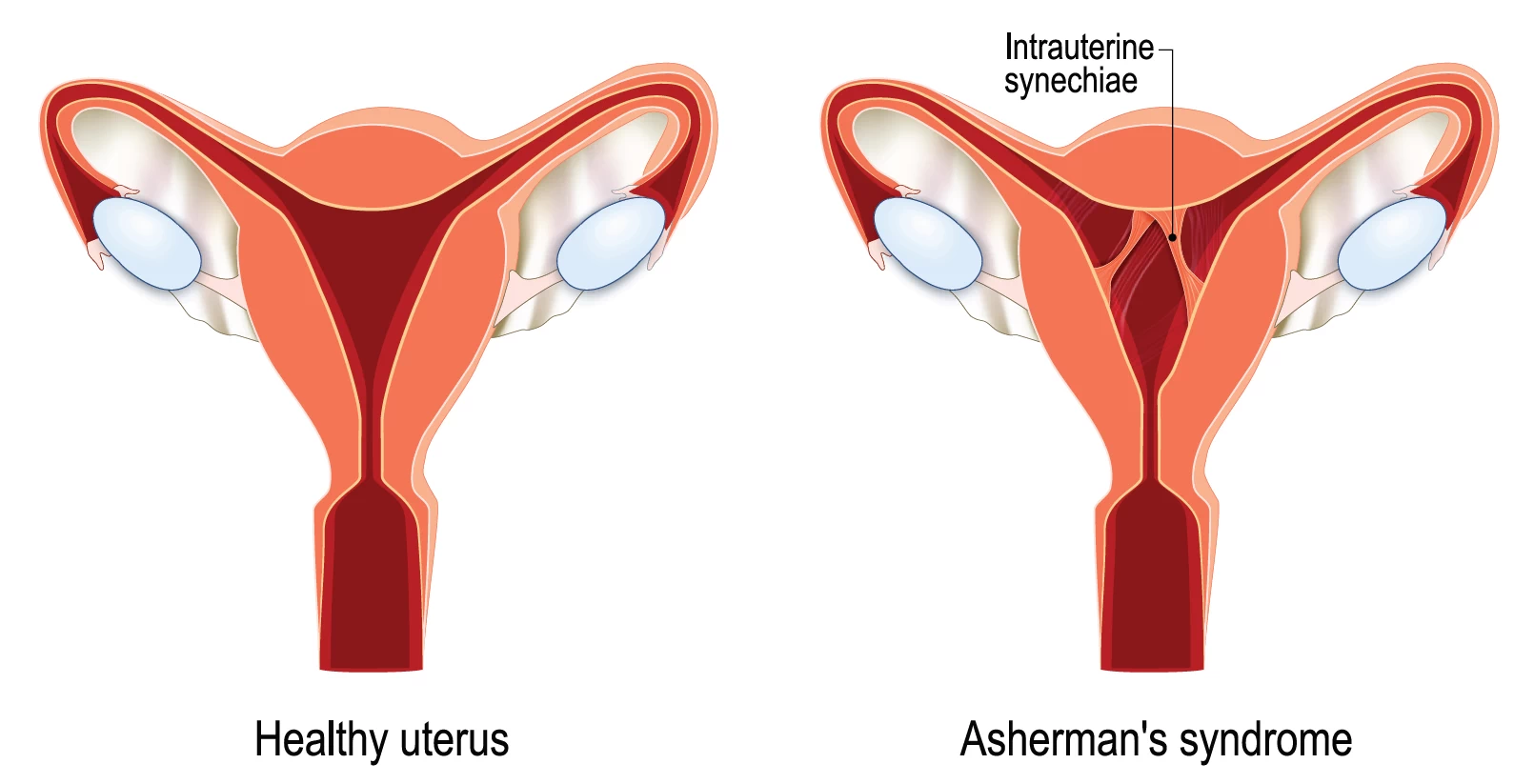
Updated 2023
What are intrauterine adhesions?
The uterus is like a balloon with walls made of layers that can grow and stretch when there is a pregnancy inside it. The innermost layer of the wall is called the endometrium. During menstruation, the endometrium is shed. When a pregnancy occurs, the embryo implants in the endometrium and the uterus can enlarge like a balloon. Injury to and/ or infection of the endometrium may damage the uterine lining and cause the formation of adhesions (scar tissue) between the inner walls of the uterus. The scarring can be mild with thin, stretchy bands of scar tissue or more severe with the formation of thick bands.

What are the potential causes of Asherman syndrome?
The most common cause of intrauterine adhesions is injury following a surgical procedure involving the cavity and lining of the uterus. Dilatation and curettage (D&C) is a common outpatient surgical procedure during which the cervix (neck of the uterus) is opened, and the tissue contents of the uterus are emptied. Intrauterine adhesions may form following a D&C performed for pregnancy complications such as uterine bleeding following childbirth or miscarriage or, less commonly, for gynecologic problems that involve the uterus. Other possible causes of adhesion formation are infections of the uterine lining (endometritis), surgical removal of fibroids in the cavity of the uterus, and endometrial ablation (a surgical procedure that is used to damage the uterine lining to reduce menstrual bleeding intentionally).
What symptoms are associated with Asherman syndrome?
An individual with intrauterine adhesions may have no obvious problems. Some, however, may experience menstrual abnormalities such as absent, light, or infrequent periods, while others may be unable to achieve pregnancy or may experience recurrent miscarriages. During childbirth, they may also experience complications due to abnormal attachment of the placenta to the uterus. Less commonly, if the scar tissue in the uterus blocks menstrual blood flow, individuals may experience pelvic pain or painful menstrual periods.
How do you make a diagnosis of Asherman syndrome?
Asherman syndrome can be diagnosed by hysteroscopy, hysterosalpingogram (HSG), or sonohysterogram (SHG). The SHG is also called a saline infusion sonohysterogram (SIS). These are imaging techniques used to visualize the inside lining and cavity of the uterus. Hysteroscopy is the most accurate method to evaluate and treat intrauterine adhesions. It is a procedure in which a thin, telescope-like instrument is inserted through the cervix to allow the doctor to see directly inside the uterus. It can be performed in the office or in the operating room. HSG and SHG are useful screening tests for adhesions. HSG is an X-ray procedure during which the uterus is infused with a dye that can be seen on the X-ray so that the shape of the inside of the uterus can be seen. During a saline ultrasound (SHG), fluid is infused through the cervix into the uterus, and a sonogram machine is used to visualize the uterine cavity.
How is Asherman syndrome treated?
Asherman syndrome is treated with surgical removal of intrauterine adhesions using hysteroscopy, which may also be performed with ultrasound guidance. This is frequently done under general anesthesia in the operating room but, in some circumstances, may be performed in a physician’s office. Following the removal of the adhesions, many surgeons recommend temporarily placing a device, such as a plastic catheter or balloon, inside the uterus to keep the walls of the uterus apart and to prevent adhesions from reforming.
Are there any long-term issues that I need to be concerned about?
Even after treatment, some patients continue to have difficulty with absent or infrequent periods. Also, pregnancies that occur after treatment may still be complicated by miscarriage, preterm labor, third-trimester bleeding, and/or abnormal attachment of the placenta to the uterine wall. The chance of successful pregnancy after treatment correlates with the type and extent of the adhesions. After treatment, patients with mild to moderate adhesions usually experience a return to normal menstrual function and have successful full-term pregnancy rates of approximately 70% to 80%. Alternatively, patients with severe adhesions or extensive destruction of the endometrial lining may have full-term pregnancy rates of only 20% to 40% after treatment. Those with extensive damage to the endometrium that does not improve after treatment may consider other options, such as adoption or in vitro fertilization (IVF) using a “gestational carrier,” where another individual carries the pregnancy created from the biological mother’s embryos.
Surgery (reproductive)
Fact Sheets/Booklets
View more fact sheets and booklets written by the ASRM Patient Education Committee.
Menopausal Transition (Perimenopause): What Is It?
The menopausal transition (perimenopause) is the period that links a woman’s reproductive (childbearing) years and menopause.
Osteoporosis
Osteoporosis and osteopenia are conditions of having low bone mass (density).
Hyperprolactinemia (High Prolactin Levels)
Prolactin is a hormone produced by your pituitary gland which sits at the bottom of the brain.Find a Health Professional











